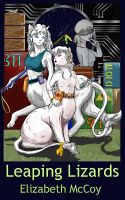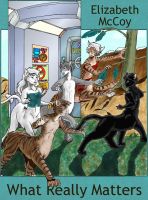Three Kintaran Stories by Elizabeth McCoy
"Leaping Lizards", "The Best Revenge", and "What Really Matters" are three science fiction short stories published as separate ebooks. They take place in the same universe, and mostly follow Kinahran, a young cat-centaur growing up on a clan-ship of her people.
I've read and listed them in publishing order, starting with the freebie introductory story. (Covers below link to Smashwords sites.)
 |
 |
 |
| Decent tale, worth a try. Jump to review |
Not my cup of tea Jump to review |
Nice mix, recommended Jump to review |
As a general note I'd like to say: Elizabeth McCoy Obviously is obviously big on worldbuilding, including conlanging. The second in my eyes is a bit problematic. It's mostly that something like leaving "khih" and "nih" ("yes" and "no") and other words in the original Kintaran when translating a line of dialogue seems illogical to me, and makes reading less smooth than it could be. (The vocabulary is given in a glossary up front in each story.)
On the plus side, I think that she does a very good job of working in information about her universe in small, natural-feeling bits—in these stories I never had the feeling of being stuck in an unneccessary infodump. Aspects of Kintaran culture are shown organically through actions or thoughts of the characters in the stories.
On to the individual tales:
When her clanship's sensors are damaged, Captain Klarin-yal hires an expensive human expert to effect repairs. Unfortunately, the human is afraid of reptiles. More unfortunately, during the explosion, a reptilian pet escaped into the ship. Even worse, the pet is about to have babies...
Now it's up to Kinahran ("Moonfur" in Terran) and her little sister Embereyes (whose pet it was anyway) to find the animal before the human flees in disgust, leaving the clanship crippled -- an outcome that would surely have the Captain using their ears for belt-pouches, and their tails for a belt!
Originally published in the fanzine Pawprints, "Leaping Lizards" is the introductory short story for the science fiction universe of the Kintarans.
Species-interaction, sibling-interaction, pets in space, and a bit of adventure, seeded with details illustrating an alien culture. Sounds good!
It took me a while to figure out why I did not like it more than I did: On a gut-level it made me, as a human, feel unwelcome, since the one in the story is assumed to be ridiculously fussy—"The engineer might leave our ship a helpless derelict if Kintaran-hair clings anywhere, or if she catches sight of a pet!" Which probably says more about the thickness of my skin than the story, or might indicate that Kinahran takes the situation a bit too seriously.
Verdict: Give it a try if you're interested in alien culture and/or cat people.
Free at Smashwords (ca. 7500 words)
When 5-year-old Kinahran breaks her leg falling off a crate (she was pushed!), she's stuck in her mother's cabin on their clanship -- much to the dismay of both child and mother! Kinahran is bored, unable to play all day with her young friends in the clanship's creche. Intolerable! And it's all her cousin's fault! But she's got a computer, a screwdriver, and a plan... for the Best Revenge.
Originally published in the fanzine Pawprints, "The Best Revenge" is a science fiction short story suitable for all ages.
"The Best Revenge" takes place several years before "Leaping Lizards", but I agree with the author that this is not the best introduction: The first time around I gave up halfway through. In addition to the half-dozen bits of vocabulary needed in the other stories, this one included several more, using them what felt like very often. I came back to this story after reading "What Really Matters" and a fourth story in this setting—the greater familiarity with the core vocabulary made reading this easier.
I still don't like this tale very much. Kinahran is a very young child here, and the scenes written from her perspective consequently have a very juvenile voice, which I find off-putting. (The other viewpoint character is her mother.)
Verdict: Probably better suited for people who are more familiar and comfortable with small children than I am. And like learning conlang words.
99 cents at Smashwords (over 4000 words)
When the clanship stops at an uninhabited, terrestrial planet, Kinahran and her friends want to play and explore. (The grown-ups make them help look for useful planetary resources to trade, as well.) But a mishap leaves their adult mentor wounded and unconscious, and when they try to radio for help, the signal is jammed! Did pirates take Kinahran's mother and baby sister hostage, or have a colony of bipeds claimed this planet as their new home? Five young Kintarans, alone in the wilderness, must find out what's going on.
This story was originally published in the fanzine Pawprints. It is suitable for most ages.
Cracking 15,000 words, you might consider this a novella. It takes place between "The Best Revenge" and "Leaping Lizards".
The story starts with the relatively non-adventurous life of young Kintarans chosing their future careers. Months of training are skimmed, hitting just a few high points—including a lovely impromptu training session for the apprentice Negotiator working "against" her teacher—before the high-tension action described in the official blurb starts. This combination worked very well for me: There was more insight in Kintaran culture, a bit of time to get to know the characters, and it explained why, when on their own, the kids were far from helpless. At the same time their decisions had a hesitancy that made them believable as prepared-but-inexperienced.
I had a bit of trouble with the many names, which I know is a weakness of mine.
This scifi adventure hits a nice balance all around, and is my favourite of the four stories in this universe that I read.
99 cents at Smashwords (over 15,000 words)
Full disclosure: I know Elizabeth McCoy from at least two online communities. She sent me a review copy of "What Really Matters" after mentioning my trouble with "The Best Revenge" to her.



Comments
They look interesting (fun cover art too), and it's nice that the author has a freebie you can start with.
I learned a new term from your review. ;) I had to look up conlang. It's something I keep to a bare minimum myself, so I guess I never needed to know. (Yes, that's my excuse. Really.)
*heh* I'm a slight language nerd and dabbled a bit, but never got far. I have some ideas in my head like "his first language doesn't inflect verbs for tense, so he'd probably say things like 'I go there yesterday' for a while when learning one that does", but didn't make up actual words in that language. So it's just trying to keep names within a culture sound like they might be from the same language (or having an excuse, like a "melting pot" country, when it is not so).
Nice reviews. The books all have interesting premises, but I can't say if I'm a fan of conlang either, especially for easily translatable terms like "Yes" and "No".
Since you were looking for review feedback...
I'd prefer it if you had the cover picture beside or directly on top of the individual review, rather than all of them at the top. I kept on scrolling up to look at which book you were referring to. An idea of the word count for the other two stories would also be helpful to put the story in context.
I'm an SF/F reader but I haven't read much books with non-human characters, so I'm not sure if I'd be willing to take the plunge with these ones. I think the factors I'd look for are tone of the work and the rules of plausibility (practical vs. Rule of Cool). I'm also interested to hear what Kintaran culture reminds you of, just so I get an idea about what they're like and whether I'd be interested in reading about them.
I like your reviews. They're balanced, detailed, fair, and I like seeing a snippet of the writing style. And I think the reviews are just the right length for short stories :)
Frida
Thank you for the detailed feedback.
I considered the other cover placement, and decided to try this one so they would show up in preview mode, because my homepage tends to be very light on images, but I'm easily swayed. ;)
I added the wordcount for each story next to the Smashword link at the end of the review. (Felt like padding to write a sentence if there was nothing to say but the number.)
It's a space opera - artificial gravity, aliens who have rather a lot in common with terran housecats - but the general feeling I get is more on the side of "building a plausible universe with these parameters" than rule of cool. (E.g. there's mention that the Kintaran homeworld and ships have a gravity 1.2 times that of earth, and effect of changing that are mentioned, things like that.)
Kintaran culture... There are surface details following the obvious: They are cats, and wash themselves with their tongues, "telegraph" moods with ears or tails... One of the major points that as far as I (who has never been owned by a cat) can tell is not linked to the cat-ness is the importance they put on being "unique" - the Kintaran word for that and one meaning "not unique" are two of the six or seven core vocables really needed. At least on a clanship the children are raised more or less communally, and it's not considered important who's a kid's father; families are matrilinear.
Not sure what to say about tone without re-reading the stories, but it might be somewhat relevant that they are suitable for all or most ages, and while "Leaping Lizards" and particularly "What Really Matters" have plenty of serious tension and sense of danger, the stories are not terribly dark.